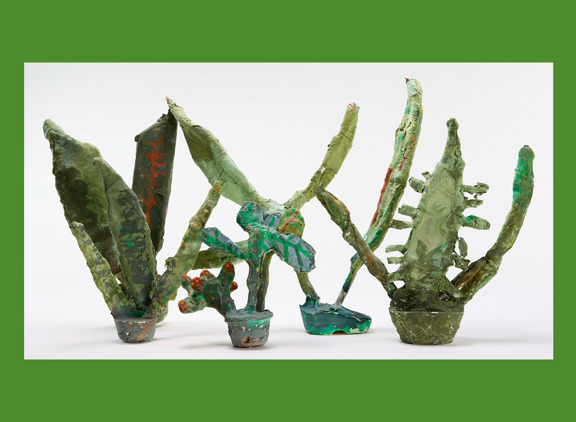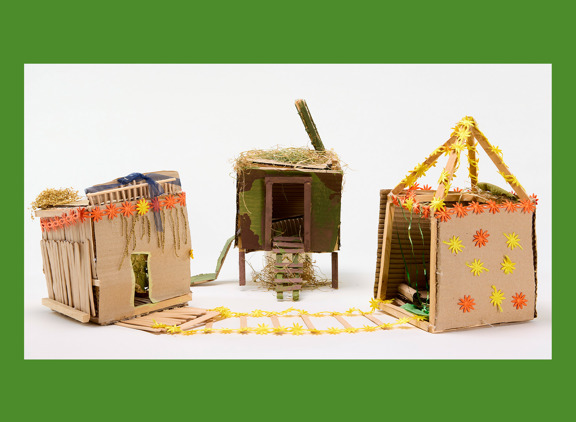The rainforest
The rainforest

Micklem Primary School, Hertfordshire, ages 4–7
Trees of knowledge
Art Club researched the rainforest and ventured out into the community to learn more about UK trees. The children were inspired to create tree sculptures using clay which represented their growth in knowledge. These were displayed in the school library with books they had read about the rainforest.
‘Look how many greens I’ve made, it’s like in the painting!’

Brockworth Primary Academy, Gloucester, ages 7–11
Surprised! diorama
One student suggested that we make a diorama to represent the jungle using different layers and a range of materials. We added clay animals to the foreground, imagining they had emerged from the forest.
‘We shared out the jobs: some people painted, some cut out and some arranged the pieces on the diorama.’

Lighthorne Heath Primary School, Warwickshire, ages 7–9
Jungle flowers
Rousseau’s plants inspired the children to create their own jungle. They researched jungle flowers and chose which ones to include. Paying close attention to the colours and shapes, the children painted their own versions and brought them together in a class artwork.
‘I enjoyed being creative and having a chance to do something collectively with my class.’

Sutton Valence Preparatory School, Kent, ages 7–8
Magnificent leaves under the microscope
The children had lots of questions about the leaves in the painting, so we looked at some real leaves under a microscope and a microbiologist came to talk to us. The pupils decided to create abstract artworks from what they saw through the microscope lens.
‘I think I want to be a microbiologist when I finish school.’

Wembrook Primary School, Warwickshire, ages 3–5
Hidden surprise
After looking at the painting, we practised our surprised faces and discussed times when we have been surprised! We decided to make an artwork with photographs of our faces hidden behind leaves, which were inspired by local plants.
‘I think Rousseau called it Surprised! because the tiger is scared. Not all surprises are nice.’

Alderman’s Green Primary School, Coventry – The Enhanced Resource Base for children with Autism Spectrum Condition, ages 5–8
Mixed media 'Surprised!'
We wanted to make our own version of the painting and focused on texture, line and colour. We experimented with collagraph printing and collage to create the background and hid tigers in the grass, just like Rousseau did.
‘I like painting yellow and green.’

St Philip’s Catholic Primary School, Leeds, ages 8–9
‘What’s lurking there?’
We wanted people to think about what they might see looking through layers of leaves and grass. This inspired our Modroc sculptures. We practised mixing and naming different shades of green before collecting sticks and leaves to help us make accurate sculptures.
‘I became more patient because the project took several days… it was a challenge to wait.’

King’s College School Murcia, Spain, ages 7–8
Raining and pouring
The painting got us thinking about our senses and we imagined what we might experience if we were in Rousseau’s scene. The whole class had noticed the rain, which inspired us to create a functioning raincloud using recycled bottles hidden behind fluffy white cotton wool.
‘We could feel the rain, see the rain, hear the rain, smell the rain and even taste the rain!’

Grange Park School, Kent – a specialist school for pupils with Autism Spectrum Condition, ages 11–13
Jungle umbrellas
The pupils were intrigued by the leaves and explored different methods to create their own, including drawing, printing and rubbing. They were also inspired by the storm, so attached their leaves to decorated umbrellas to create hanging sculptures.
‘The leaves are swaying and the jungle is filled with green trees and leaves.’

Two Mile Ash School, Milton Keynes, ages 10–11
Sensory exploration
Our class read a book featuring a boy called Thomas, who has a visual impairment. We wanted to make the painting more accessible through touch, so we made wool paintings, and boxes with tactile leaves and words which describe the painting in braille.
‘Sewing the leaves was challenging. I really had to concentrate on my stitching to make sure it was bumpy enough to be felt by people’s fingers.’

Pencalenick School, Truro – a school for students with complex learning needs, ages 11–14
Lovely leaves
The pupils collected leaves to study and were interested to discover different shapes, patterns and shades of green, which inspired their mobiles. They made leaf models from sticks, masking tape and tissue paper and attached hanging fabric leaves with fishing wire. The leaves are embroidered with details that the pupils observed in real plants.
'I like using the hand sewing machine best.'

Grimes Dyke Primary School, Leeds, ages 10–11
Treehouses
We questioned how we would survive if we were in the painting. We thought that we would need shelter, so decided to create treehouses using our DT skills. We then photographed our models in the local woods and thought about how well they blended into the environment.
‘It was a challenge to make them look as if they could really be part of the rainforest.’

Moorlands Junior School, Cheshire, ages 7–8
Local leaves
Together, we wondered where the picture was set, so our class went out into the neighbourhood to find leaves to compare to those in the painting. Our leaves looked very different, so we decided that the picture was not set in England and used the leaves we had collected to print into clay.
‘I noticed some of the leaves in the painting had red and brown tones so I wanted to use some of those colours in my design.’

Chenies School, Hertfordshire, ages 5–7
Recycled plastic jungle
We thought that the tiger might be injured, so we visited a wildlife hospital and discovered that many wild animals get injured by litter. We decided to collect bottles, bags and packaging to make a plastic jungle, turning the potentially dangerous rubbish into art.
‘I like the light shining through the bottles.’

John Bunyan Primary School and Nursery, Essex, ages, 4–5
‘Let’s make rain!’
We felt cold and wet when we listened to the soundscape that the National Gallery made for Surprised! We wanted to recreate the storm, so we put rice and lentils into a tube with tinfoil and newspaper to make a giant rainstick. We then decorated it with the colours that we had noticed in the painting.
‘I can hear the rain and the big storm.’
